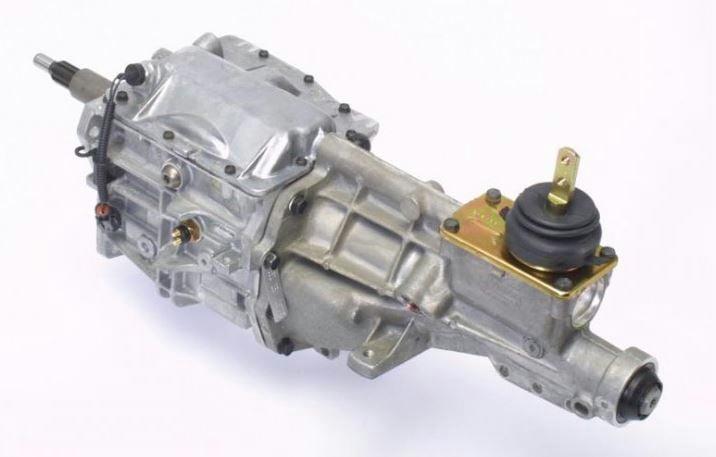Tremec / BorgWarner T-5 — Practical Guide for Ford Enthusiasts
The five-speed T-5 (originally BorgWarner, later produced by Tremec) is one of the most widely used light-car five-speed transmissions. It was fitted to many Ford Mustangs and other models through the 1980s and 1990s and remains popular for swaps and restomod projects because of its relatively light weight, overdrive 5th gear, and broad parts availability.
Brief History & Design Highlights
The T-5 evolved from earlier light-duty manuals by adding an overdrive gear and adopting different case materials and internal configurations over time. Early BorgWarner units (often called “Non-World Class” or NWC) differ internally from the later “World Class” (WC) units in synchros, bearings, and some gear materials. Tremec later manufactured updated T-5 designs and Ford Racing/Ford Performance sold heavy-duty service replacements (e.g., the M-7003-Z) for high-duty Mustang applications.
World Class vs Non-World Class — What Matters
“World Class” refers to a set of design changes (synchros, bearing arrangements, and some gear/bearing materials) that improved shift quality and durability in many applications. Because T-5 parts and tailhousings were swapped frequently, the assembly tag (the 1352-xxx number) is the best starting point for identification but always verify pilot diameter and input shaft length before planning a transplant.
Why Identification Matters
There are many T-5 sub-families. Differences that matter for swaps and repairs include pilot diameter (commonly ~0.668″ for many V-6/V-8 units and ~0.59″ for many 4-cylinder units), input shaft spline/count, input shaft length, speedometer drive gear (tooth count), and the internal gearset ratios (which affect final drive behavior). Always use tag + measured verification.
Typical Gearsets Used by Ford
- 3.35 / 1.99 / 1.33 / 1.00 / 0.68 — common V-8 street/stock ratio family used across many Mustang T-5s.
- 2.95 / 1.94 / 1.34 / 1.00 / 0.63 — close-ratio heavy-duty family used on some motorsport/aftermarket and Ford Performance heavy duty replacements (M-7003-Z).
- 3.97 / 2.34 / 1.46 / 1.00 / 0.79 — commonly seen in many 4-cylinder or lighter-duty applications.
Common Weak Spots & Maintenance Tips
- 3rd-gear / 3–4 synchronizer area — worn synchros or 3rd gear damage shows up as crunching, missed shifts, or inability to hold 3rd under load.
- Fluid and service — T-5 variants have recommended lubricants (original NWC types often used heavier gear oils); check the donor vehicle’s specification and the rebuild manual before filling.
- Torque limits — stock T-5 torque ratings vary; heavy-duty versions and Ford Racing/Tremec upgrades (M-7003-Z and equivalents) increase torque capacity, but for very high-power V-8 builds many builders choose a heavier Tremec model.
Swap Checklist — Practical Steps Before Buying a Donor T5
- Read the
1352-xxxtag and cross-reference it with your ID chart. - Measure pilot diameter and input shaft length. Confirm spline counts and the bellhousing bolt pattern.
- Confirm speedometer drive gear tooth count for mechanical speedos or that the electronic vehicle speed sensor (VSS) matches your speedo setup.
- Confirm gear ratios match desired final drive and use case (street, towing, motorsport).
- If the plan is to increase engine torque beyond stock, consider a rebuilt T-5 with upgraded cluster gears, upgraded synchros, or move to a heavier Tremec option.
How To Measure Pilot Diameter & Input Shaft Length
Why measure? Pilot diameter and input shaft length are the two most common reasons a T-5 won’t drop into a different bellhousing or clutch setup. The wrong pilot can cause clutch misalignment and damage the crank/bearing surface. Always measure before assuming compatibility.
Tools & supplies
- Vernier calipers (0–6″ digital preferred) or an outside micrometer
- Small straightedge or depth gauge (for length)
- Shop light and safety glasses
- Gloves and a clean rag
Measuring pilot diameter
- Clean the pilot area (the cylindrical nose that fits into the crank pilot/bearing).
- Use the calipers to measure the pilot diameter at its largest cross-section.
- Record the measurement to three decimal places (e.g., 0.668″ or 0.590″).
Measuring input shaft length
- Measure from the face of the bellhousing mating surface to the end of the input shaft pilot.
- Record the measurement. Typical Mustang T-5 input lengths are ~7.18″ or ~7.41″ for many V-8 units.
Safety note: If you’re unsure, bring the transmission and clutch/flywheel to a driveline shop for verification.
Ford T5 Identification Chart
| B/W
1352- |
Year / Model (Notes) |
Torque Max (lb/ft) |
Gear Ratios 1st / 2nd / 3rd / 4th / 5th (Reverse) |
Speedo Drive Gear |
Input Shaft Length (in) |
Input Shaft Pilot Dia (in) |
|---|---|---|---|---|---|---|
| 114 | 85-86 Thunderbird 2.3 T | 235 |
4.03 / 2.37 / 1.49 / 1.00 / 0.81 (3.76) |
6 | 7.41 | 0.590 |
| 115 | 79-83 Mustang 5.0
(a) |
305 |
2.95 / 1.94 / 1.34 / 1.00 / 0.63 (2.76) |
6 | 7.18 | 0.668 |
| 116 | 85-86 SVO 2.3 | 250 |
3.50 / 2.14 / 1.39 / 1.00 / 0.78 (3.39) |
6 | 7.41 | 0.59 |
| 126 | 85 Mustang 5.0 | 265 |
3.35 / 1.93 / 1.29 / 1.00 / 0.68 (3.15) |
7 | 7.18 | 0.668 |
| 141 | 86 Mustang 5.0 | 265 |
3.35 / 1.93 / 1.29 / 1.00 / 0.68 (3.15) |
7 | 7.18 | 0.668 |
| 154 | 87 Mustang 2.3 | 240 |
3.97 / 2.34 / 1.46 / 1.00 / 0.85 (3.70) |
7 | 7.41 | 0.59 |
| 155 | 87 T-Bird 2.3T | 240 |
3.97 / 2.34 / 1.46 / 1.00 / 0.79 (3.70) |
6 | 7.41 | 0.59 |
| 162 | 87-88 Mustang 2.3 | 240 |
3.97 / 2.34 / 1.46 / 1.00 0.79 (3.70) |
7 | 7.41 | 0.59 |
| 165 | 86 Mustang 5.0 | 265 |
3.35 / 1.93 / 1.29 / 1.00 / 0.68 (3.15) |
7 | 7.18 | 0.668 |
| 169 | 86.5-89 Mustang 5.0 | 265 |
3.35 / 1.93 / 1.29 / 1.00 / 0.68 (3.15) |
7 | 7.18 | 0.668 |
| 194 | 89-90 Mustang 2.3 | 240 |
3.97 / 2.34 / 1.46 / 1.00 / 0.79 (3.70) |
7 | 7.41 | 0.59 |
| 199 |
90-91 Mustang 5.0 (b) |
300 |
3.35 / 1.99 / 1.33 / 1.00 / 0.68 (3.15) |
8 | 7.18 | 0.668 |
| 200 | 79-93 Mustang 5.0
(a) |
305 |
2.95 / 1.94 / 1.34 / 1.00 / 0.63 (2.76) |
7 | 7.18 | 0.668 |
| 202 | 79-93 Mustang 5.0
(c) |
305 |
2.95 / 1.94 / 1.34 / 1.00 / 0.80 (2.76) |
7 | 7.18 | 0.668 |
| 204 | 85-89 Mustang 5.0 | 300 |
3.35 / 1.99 / 1.33 / 1.00 / 0.68 (3.15) |
7 | 7.18 | 0.668 |
| 207 | 91 Mustang 2.3 | 240 |
3.97 / 2.34 / 1.46 / 1.00 / 0.79 (3.70) |
7 | 7.41 | 0.59 |
| 208 | 92-93 Mustang 5.0
(d) |
300 |
3.35 / 1.99 / 1.33 / 1.00 / 0.68 (3.15) |
8 | 7.18 | 0.668 |
| 209 | 92-93 Mustang 2.3 | 240 | 3.97 / 2.34 / 1.46 / 1.00 / 0.79
(3.70) |
7 | 7.41 | 0.59 |
| 218 | 93 Mustang Cobra
(e) |
310 |
3.35 / 1.99 / 1.33 / 1.00 / 0.68 (3.15) |
8 | 7.18 | 0.668 |
| 219 | 94 Mustang 5.0 | 300 |
3.35 / 1.99 / 1.33 / 1.00 / 0.68 (3.15) |
8 | 7.85 | 0.668 |
| 220 | 94 Mustang 3.8 | 265 |
3.35 / 1.93 / 1.29 / 1.00 / 0.73 (3.15) |
7 | 7.85 | 0.668 |
| 225 | 79-93 Mustang 5.0
(b,c,d) |
325 |
2.95 / 1.94 / 1.34 / 1.00 / 0.80 (2.76) |
7 | 7.18 | 0.668 |
| 227 | 79-93 Mustang 5.0
(b,c,d,f) |
325 |
2.95 / 1.94 / 1.34 / 1.00 / 0.63 (2.76) |
7 | 7.18 | 0.668 |
| 236 | 94 1/2 Mustang 3.8 | 265 |
3.35 / 1.93 / 1.29 / 1.00 / 0.73 (3.15) |
7 | 7.85 | 0.668 |
| 238 | 94-97 Mustang 3.8 | 265 |
3.35 / 1.93 / 1.29 / 1.00 / 0.73 (3.15) |
8 | 7.85 | 0.668 |
| 239 | 93 Mustang Cobra (c,e) | 310 |
3.35 / 1.99 / 1.33 / 1.00 / 0.68 (3.15) |
8 | 7.18 | 0.68 |
| 242 | 94-95 Mustang Cobra
(e) |
310 |
3.35 / 1.99 / 1.33 / 1.00 / 0.68 (3.15) |
8 | 7.85 | 0.668 |
| 246 | 94-95 Mustang 5.0 | 300 |
3.35 / 1.99 / 1.33 / 1.00 / 0.68 (3.15) |
8 | 7.85 | 0.668 |
| 249 | 79-93 Mustang 5.0
(e,g) |
330 |
2.95 / 1.94 / 1.34 / 1.00 / 0.63 (2.76) |
7 | 7.18 | 0.668 |
| 251 | 79-93Mustang 5.0
(c,e) |
330 |
2.95 / 1.94 / 1.34 / 1.00 / 0.63 (2.76) |
7 | 7.18 | 0.668 |
| 253 | 94-95 Mustang Cobra
(c,e) |
310 |
3.35 / 1.99 / 1.33 / 1.00 / 0.68 (3.15) |
8 | 7.85 | 0.668 |
|
Input Shaft = 1-1/16 inch/10 spline Ouput Shaft = 28 SplinesNotes: Notes: a) Motorsport M-7003-A b) Improved Steel Alloy c) Aftermarket d) Carbon fiber 3/4 blocker rings e) Cobra tapered roller pocket bearing f) Motorsport M-7003-X g) Motorsport M-7003-Z |
||||||
Jim Oaks is the founder of TheRangerStation.com, the longest-running Ford Ranger resource online since 1999. With over 25 years of hands-on experience building and modifying Ford Rangers — including magazine-featured builds like Project Transformer — Jim has become one of the most trusted authorities in the Ford Ranger off-road and enthusiast space. In 2019, he was loaned a Ranger FX4 by Ford Motor Company to test and document across the TransAmerica Trail. Jim continues to inspire and guide Ranger owners around the world.

